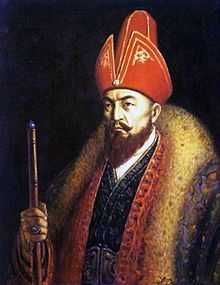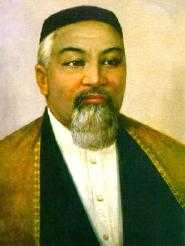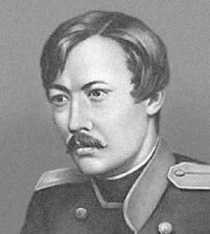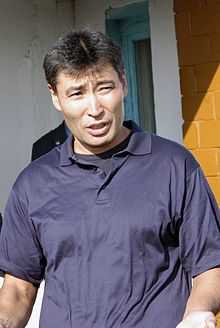Kazakhs
| |||||||||||||||||||||
| Total population | |||||||||||||||||||||
|---|---|---|---|---|---|---|---|---|---|---|---|---|---|---|---|---|---|---|---|---|---|
| 17,000,000 | |||||||||||||||||||||
| Regions with significant populations | |||||||||||||||||||||
| 11,244,547 (1.01.2014)[1] | |||||||||||||||||||||
| 1,500,000[2] | |||||||||||||||||||||
| 1,100,000[3] | |||||||||||||||||||||
| 647,732[4] | |||||||||||||||||||||
| 101,526[5] | |||||||||||||||||||||
| 46,633[6] | |||||||||||||||||||||
| 40,000[7] | |||||||||||||||||||||
| 33,200[8] | |||||||||||||||||||||
| 10,000[9] | |||||||||||||||||||||
| 5,526[10] | |||||||||||||||||||||
| 3,000 - 4,000 to 15,000[11][12] | |||||||||||||||||||||
| 1,685[13] | |||||||||||||||||||||
| 1,355[14] | |||||||||||||||||||||
| Languages | |||||||||||||||||||||
| Kazakh | |||||||||||||||||||||
| Religion | |||||||||||||||||||||
| Sunni Islam | |||||||||||||||||||||
| Related ethnic groups | |||||||||||||||||||||
| Karakalpaks, Nogais | |||||||||||||||||||||
The Kazakhs (also spelled Kazaks, Qazaqs; Kazakh: Қазақ ![]() qɑzɑ́q , Қазақтар
qɑzɑ́q , Қазақтар ![]() qɑzɑqtɑ́r ; the English name is transliterated from Russian) are a Turkic people of the northern parts of Central Asia (largely Kazakhstan, but also found in parts of Uzbekistan, China, Russia and Mongolia). Kazakh identity is of medieval origin and was strongly shaped by the foundation of the Kazakh Khanate between 1456 and 1465, when several tribes under the rule of the sultans Janybek and Kerey departed from the Khanate of Abu'l-Khayr Khan. After the collapse of the Soviet Union, most of the modern Kazakhs are not religious or non-denominational muslim.
qɑzɑqtɑ́r ; the English name is transliterated from Russian) are a Turkic people of the northern parts of Central Asia (largely Kazakhstan, but also found in parts of Uzbekistan, China, Russia and Mongolia). Kazakh identity is of medieval origin and was strongly shaped by the foundation of the Kazakh Khanate between 1456 and 1465, when several tribes under the rule of the sultans Janybek and Kerey departed from the Khanate of Abu'l-Khayr Khan. After the collapse of the Soviet Union, most of the modern Kazakhs are not religious or non-denominational muslim.
Kazakhs are descendants of the Turkic tribes – Argyns, Khazars, Qarluqs; and of the Kipchaks and Cumans,[15][16] and other tribes such as the Huns, and ancient nomads like the Sarmatians, Saka and Scythians from East Europe populated the territory between Siberia and the Black Sea and remained in Central Asia and Eastern Europe when the nomadic groups started to invade and conquer the area between the 5th and 13th centuries AD.[17][18][19][20]
Kazakhs were one of the nations most severely affected by the Soviet famine of 1932–33, with 37% of the total population dying.[21]
Etymology of Kazakh
The Kazakhs probably began using this name during either the 15th or 16th centuries.[22] There are many theories on the origin of the word Kazakh or Qazaq. Some speculate that it comes from the Turkish verb qaz (to wander), because the Kazakhs were wandering steppemen; or that it derives from the prototurkic word khasaq (a wheeled cart used by the Kazakhs to transport their yurts and belongings).[23]
In the 19th century, one etymological explanation was that the name came from the popular Kazakh legend of the white goose (qaz means "goose", aq means "white").[23][24] In this creation myth, a white steppe goose turned into a princess, who in turn gave birth to the first Kazakh. This etymological derivation is regarded as flawed because, in Turkic languages, the adjective is put before the noun, and therefore "white goose" would be Aqqaz, not Qazaq.
Another theory on the origin of the word Kazakh (originally Qazaq) is that it comes from the ancient Turkic word qazğaq, first mentioned on the 8th century Turkic monument of Uyuk-Turan. According to the notable Turkic linguist Vasily Radlov and the orientalist Veniamin Yudin, the noun qazğaq derives from the same root as the verb qazğan ("to obtain", "to gain"). Therefore, qazğaq defines a type of person who seeks profit and gain.[25]
Kazakh
Kazakh was a common term throughout medieval Central Asia, generally with regard to individuals or groups who had taken or achieved independence from a figure of authority. Timur described his own youth without directory authority as his Qazaqliq (Qazaqness).[26] At the time of the Uzbek nomads' Conquest of Central Asia, the Uzbek khan Abul-Khayr had differences with the Chinggisid chiefs Giray/Kirey and Janibeg/Janibek, descendants of Urus Khan.

These differences probably resulted from the crushing defeat of Abul-Khayr Khan at the hands of the Qalmaqs.[27] Kirey and Janibek moved with a large following of nomads to the region of Zhetysu/Semirechye on the border of Moghulistan and set up new pastures there with the blessing of the Moghul Chingisid Esen Buqa, who hoped for a buffer zone of protection against the expansion of the Oirats.[28] It is not explicitly explained that this is why the later Kazakhs took the name permanently, but it is the only historically verifiable source of the ethnonym. The group under Kirey and Janibek are called in various sources Qazaqs and Uzbek-Qazaqs (those independent of the Uzbek khans). Later Russian language sources incorrectly termed them Kirghiz and Kirghiz-Kaisak.
The word Kazakh stems largely from a Russian convention seeking to distinguish the Qazaqs of the steppes from the Cossacks of the Russian Imperial military.
- Kazakh – Казах
- Cossack – Казак
The Russian term Cossack probably comes from the same Kypchak etymological root, i.e. wanderer, brigand, independent free-booter.
Oral history
Due to their nomadic pastoral lifestyle, Kazakhs kept an epic tradition of oral history. The nation, which amalgamated nomadic tribes of various Kazakh origins, managed to preserve the distant memory of the original founding clans. It was important for a Kazakh to know his or her genealogical tree for no less than seven generations back (known as şejire, from the Arabic word shajara – "tree").
Three Kazakh Hordes

Junior juz |
Middle juz |
Great juz |
In modern Kazakhstan, tribalism is fading away in business and government life. Still it is common for Kazakhs to ask which tribe they belong to when they meet each other. Nowadays, it is more of a tradition than necessity. There is no hostility between tribes. Kazakhs, regardless of their tribal origin, consider themselves one nation.
The majority of Kazakhs of modern-day Kazakhstan belong to one of the three juzes (juz, roughly translatable as "horde" or "hundred"):
- The Elder, Senior, or Great Horde (Ulı Juz)
- The Middle or Central Horde (Orta juz)
- The Junior, Younger, or Lesser Horde (Kişi juz)
History of the Hordes
There is much debate surrounding the origins of the Hordes. Their age is unknown so far in extant historical texts, with the earliest mentions in the 17th century. The Turkologist Velyaminov-Zernov believed that it was the capture of the important cities of Tashkent, Yasi, and Sayram in 1598 by Tevvekel (Tauekel/Tavakkul) Khan that separated the Qazaqs, as only a portion of the Century possessed the cities.[29] This theory suggests that the Qazaqs then divided among a wider territory after expanding from Zhetysu into most of the Dasht-i Qipchaq, with a focus on the trade available through the cities of the middle Syr Darya, of which Sayram and Yasi belonged.
Language
The Kazakh language is a member of the Turkic language family, as are Uzbek, Kyrgyz, Tatar, Uyghur, Turkish, Azeri, Turkmen, and many other living and historical languages spoken in Eastern Europe, Central Asia, Xinjiang, and Siberia.
Kazakh belongs to the Kipchak (Northwestern) group of the Turkic language family. Kazakh is characterized, in distinction to other Turkic languages, by the presence of /s/ in place of reconstructed proto-Turkic */ʃ/ and /ʃ/ in place of */tʃ/; furthermore, Kazakh has /dʒ/ where other Turkic languages have /j/.
Kazakh, like most of the Turkic language family lacks phonemic vowel length, and as such there is no distinction between long and short vowels.
Kazakh was written with the Arabic script during the 19th century, when a number of poets, educated in Islamic schools, incited revolt against Russia. Russia's response was to set up secular schools and devise a way of writing Kazakh with the Cyrillic alphabet, which was not widely accepted. By 1917, the Arabic script was reintroduced, even in schools and local government.
In 1927, a Kazakh nationalist movement sprang up but was soon suppressed. At the same time the Arabic script was banned and the Latin alphabet was imposed for writing Kazakh. The native Latin alphabet was in turn replaced by the Cyrillic alphabet in 1940 by soviet interventionists. Today, there are efforts to return to the Latin script.
Kazakh is a state (official) language in Kazakhstan. It is also spoken in the Ili region of the Xinjiang Uyghur Autonomous Region in the People's Republic of China, where the Arabic script is used, and in western parts of Mongolia (Bayan-Ölgii and Khovd province), where Cyrillic script is in use. European Kazakhs use the Latin alphabet.
Religion

Ancestors of modern Kazakhs believed in Shamanism and Tengrism, then Zoroastrianism, Buddhism and Christianity including Church of the East. Islam was firstly introduced to ancestors of modern Kazakhs during the 8th century when the Arab missionaries entered Central Asia. Islam initially took hold in the southern portions of Turkestan and thereafter gradually spread northward.[30] Islam also took root due to the zealous missionary work of Samanid rulers, notably in areas surrounding Taraz[31] where a significant number of Turks accepted Islam. Additionally, in the late 14th century, the Golden Horde propagated Islam amongst the Kazakhs and other tribes. During the 18th century, Russian influence toward the region rapidly increased throughout Central Asia. Led by Catherine, the Russians initially demonstrated a willingness in allowing Islam to flourish as Muslim clerics were invited into the region to preach to the Kazakhs whom the Russians viewed as "savages" and "ignorant" of morals and ethics.[32][33] However, Russian policy gradually changed toward weakening Islam by introducing pre-Islamic elements of collective consciousness.[34] Such attempts included methods of eulogizing pre-Islamic historical figures and imposing a sense of inferiority by sending Kazakhs to highly elite Russian military institutions.[34] In response, Kazakh religious leaders attempted to bring religious fervor by espousing pan-Turkism, though many were persecuted as a result.[35] During the Soviet era, Muslim institutions survived only in areas where Kazakhs significantly outnumbered non-Muslims due to everyday Muslim practices.[36] In an attempt to conform Kazakhs into Communist ideologies, gender relations and other aspects of the Kazakh culture were key targets of social change.[33]
In more recent times however, Kazakhs have gradually employed a determined effort in revitalizing Islamic religious institutions after the fall of the Soviet Union. Some Kazakhs continue to identify with their Islamic faith,[37] and even more devotedly in the countryside. Those who claim descent from the original Muslim soldiers and missionaries of the 8th century command substantial respect in their communities.[38] Kazakh political figures have also stressed the need to sponsor Islamic awareness. For example, the Kazakh Foreign Affairs Minister, Marat Tazhin, recently emphasized that Kazakhstan attaches importance to the use of "positive potential Islam, learning of its history, culture and heritage."[39]
Pre-Islamic beliefs—the worship of the sky, of the ancestors, and of fire, for example—continued to a great extent to be preserved among the common people, however. The Kazakhs believed in the supernatural forces of good and evil spirits, of wood goblins and giants. To protect themselves from them, as well as from the evil eye, the Kazakhs wore protection beads and talismans. Shamanic beliefs are still widely preserved among the Kazakhs, as well as belief in the strength of the bearers of this worship—the shamans, which the Kazakhs call bakhsy. In contradistinction to the Siberian shamans, who used drums during their rituals, the Kazakh shamans, who could also be men or women, played (with a bow) on a stringed instrument similar to a large violin. At present both Islamic and pre-Islamic beliefs continue to be found among the Kazakhs, especially among the elderly.[40] According to 2009 national census 39,172 Kazakhs are Christians.[41]
Genetic studies
A full study of the genetic makeup of the Kazakh population is far from being finished. According to mitochondrial DNA studies[42] (where sample consisted of only 246 individuals), the main maternal lineages of Kazakhs are: D (17.9%), C (16%), G (16%), A (3,25%), F (2.44%), which is of eastern-eurasian origin (58%), and haplogroups H (14.1), T (5.5), J (3.6%), K (2.6%), U5 (3%), and others (12.2%) of western Eurasian origin (41%). An analysis of ancient Kazakhs found that East Asian haplogroups such as A and C did not begin to move into the Kazakh steppe region till around the time of the Xiongnu (1st millennia BC), which is around the onset of the Sargat Culture as well (Lalueza-Fox 2004).[43]
In a sample of 54 Kazakhs and 119 Altaian Kazakh. The main paternal lineages of Kazakhs are: C (66.7% and 59.5%), O (9% and 26%), N (2% and 0%), J (4% and 0% ), R ( 9% and 1% ).[44]




Population
| 1897 | 1911 | 1926 | 1939 | 1959 | 1970 | 1979 | 1989 | 1999 | 2008 | 2009 |
|---|---|---|---|---|---|---|---|---|---|---|
| 73.9% | 60.8% | 59.5% | 38.0% | 30.0% | 32.6% | 36.0% | 39.7% | 53.4% | 59.8% | 63.1% |
Historical population of Kazakhs: [45]
| Year | Population |
|---|---|
| 1600 | 1,200,000? |
| 1900 | 2 million? (1,5-3 million) |
| 1939 | 4,000,000? |
| 1970 | 6,500,000? |
| 2013 | 13,600,000 |
Kazakh minorities
Russia
In Russia, the Kazakh population lives primarily in the regions bordering Kazakhstan. According to latest census (2002) there are 654,000 Kazakhs in Russia, most of whom are in the Astrakhan, Volgograd, Saratov, Samara, Orenburg, Chelyabinsk, Kurgan, Tyumen, Omsk, Novosibirsk, Altai Krai and Altai Republic regions. Though ethnically Kazakh, after the dissolution of the Soviet Union in 1991, these people acquired Russian citizenship.
| 1939 | % | 1959 | % | 1970 | % | 1979 | % | 1989 | % | 2002 | % |
|---|---|---|---|---|---|---|---|---|---|---|---|
| 356 646 | 0.33 | 382 431 | 0.33 | 477 820 | 0.37 | 518 060 | 0.38 | 635 865 | 0.43 | 653 962 | 0.45 |
China

Kazakhs, called Hāsàkè Zú in Chinese (哈萨克族; literally "Kazakh people" or "Kazakh tribe") are among 56 ethnic groups officially recognized by the People's Republic of China. Thousands of Kazakhs fled to China during the 1932-1933 famine in Kazakhstan. In 1936, after Sheng Shicai expelled 30,000 Kazakhs from Xinjiang to Qinghai, Hui led by General Ma Bufang massacred their fellow Muslim Kazakhs, until there were 135 of them left.[47][48][49] In China there is one Kazakh autonomous prefecture, the Ili Kazakh Autonomous Prefecture in the Xinjiang Uyghur Autonomous Region, three Kazakh autonomous counties, Aksai Kazakh Autonomous County in Gansu, Barkol Kazakh Autonomous County and Mori Kazakh Autonomous County in the Xinjiang Uyghur Autonomous Region. Many Kazakhs in China are not fluent in Standard Chinese, instead speaking the Kazakh language. Since the early 21st century, Mamuer Rayeskan, a young Kazakh musician from Qitai, Xinjiang now living in Beijing, has achieved some renown for his reworking of Kazakh folk songs with his group IZ, with which he sings and plays acoustic guitar, dombra, and jaw harp. "In that place wholly faraway", based on a Kazakh folk song, is very popular outside the Kazakh regions, especially in the Far Eastern countries of China, Japan and Korea.
Mongolia
In the 19th century, the advance of the Russian Empire troops pushed Kazakhs to neighboring countries. In around 1860, part of the Middle Jüz Kazakhs came to Mongolia and were allowed to settle down in Bayan-Ölgii, Western Mongolia and for most of the 20th century they remained an isolated, tightly knit community. Ethnic Kazakhs (so-called Altaic Kazakhs or Altai-Kazakhs) live predominantly in Western Mongolia in Bayan-Ölgii Province (88.7% of total province population) and Khovd Province (11.5% of total province population, living primarily in the Khovd city, Khovd sum and Buyant sum). In addition, a number of Kazakh communities can be found in various cities and towns spread throughout the country. Some of the major population centers with a significant Kazakh presence include Ulaanbaatar (90% in khoroo #4 of Nalaikh düüreg,[50] Töv and Selenge provinces, Erdenet, Darkhan, Bulgan, Sharyngol (17.1% of population total)[51] and Berkh cities.
| 1956 | % | 1963 | % | 1969 | % | 1979 | % | 1989 | % | 2000 | % | 2010[5] | % |
|---|---|---|---|---|---|---|---|---|---|---|---|---|---|
| 36,729 | 4.34 | 47,735 | 4.69 | 62,812 | 5.29 | 84,305 | 5.48 | 120,506 | 6.06 | 102,983 | 4.35 | 101,526 | 3.69 |
Uzbekistan
400,000 Kazakhs live in Karakalpakstan and 100,000 in the Tashkent province. Since the fall of Soviet Union, vast majority of Kazakh people are returning to Kazakhstan, mainly to Manghistau Oblast'. Most Kazakhs in Karakalpakstan are descendants of one of the branches of "Junior juz" (Kişi juz) -Adai tribe.
Iran
Iranian Kazakhs live mainly in the Golestan Province in northern Iran.[53] According to ethnologue.org, in 1982 there were 3000 Kazakhs living in the city of Gorgan.[54][55] Since fall of the Soviet Union number of Kazakhs in Iran decreased due to emigration to their historical Motherland."[56]
Culture
Music
Many are also skilled in the performance of Kazakh traditional songs. One of the most commonly used traditional musical instruments of the Kazakhs is the dombra, a plucked lute with two strings. It is often used to accompany solo or group singing. Another popular instrument is kobyz, a bow instrument played on the knees. Along with other instruments, these two instruments play a key role in the traditional Kazakh orchestra. A notable composer is Kurmangazy, who lived in the 19th century. After studying in Moscow, Gaziza Zhubanova became the first woman classical composer in Kazakhstan, whose compositions reflect Kazakh history and folklore. A notable singer of the Soviet epoch is Roza Rymbaeva, she was a star of the trans-Soviet-Union scale. A notable Kazakh rock band is Urker, performing in the genre of ethno-rock, which synthesises rock music with the traditional Kazakh music.
See also
Notable Kazakhs
References
- ↑ Агентство Республики Казахстан по статистике. Этнодемографический сборник Республики Казахстан 2014.
- ↑ Census 2000 counts 1.25 mln Kazakhs The Kazak Ethnic Group, later the Kazakh population had higher birth rate, but some assimilation processes were present too. Estimatians made after the 2000 Census claim Kazakh population share growth (was 0.104% in 2000), but even if this share value was preserved at 0.104% level it would be no less than 1.4 mln in 2008
- ↑ Kazakh population share was constant at 4.1% in 1959–1989, CIA estimates this share declined to 3% in 1996. Official Uzbekistan estimation (E. Yu. Sadovskaya "Migration in Kazakhstan in the beginning of the 21st century: main tendentions and perspectives" ISBN 978-9965-593-01-7) in 1999 was 940,600 Kazakhs or 3.8% of total population. If Kazakh population share was stable at about 4.1% (not taking into account the massive repatriation of ethnic Kazakhs (Oralman) to Kazakhstan) and the Uzbekistan population in the middle of 2008 was 27.3 mln, the Kazakh population would be 1.1 mln. Using the CIA estimate of the share of Kazakhs (3%), the total Kazakh population in Uzbekistan would be 0.8 mln
- ↑ Russia National Census 2010
- ↑ 5.0 5.1 Mongolia National Census 2010 Provision Results. National Statistical Office of Mongolia (in Mongolian.)
- ↑ "Anzahl der Ausländer in Deutschland nach Herkunftsland (Stand: 31. Dezember 2014)".
- ↑ In 1995 Kazakh population was 86,987 or 1.94% population total. Later was a massive pepartriation of ethnic Kazakh population (oralman) to Kazakhstan: 22,000 before 2001 and 38,000–40,000 in 2001—2007. Press reports are claiming ,, the most part of Kazakhs had left Turkmenistan
- ↑ In 2009 National Statistical Committee of Kyrgyzstan. National Census 2009
- ↑ "Казахское общество Турции готово стать объединительным мостом в крепнущей дружбе двух братских народов - лидер общины Камиль Джезер". Retrieved 18 March 2015.
- ↑ Ukrainian population census 2001: Distribution of population by nationality. Retrieved on 23 April 2009
- ↑ "Êàçàõè "ÿäåðíîãî" Èðàíà". Retrieved 18 March 2015.
- ↑ ""Казахи доказали, что являются неотъемлемой частью иранского общества и могут служить одним из мостов, связующих две страны" - представитель диаспоры Тойжан Бабык". Retrieved 18 March 2015.
- ↑ Statistik Austria. "STATISTIK AUSTRIA - Bevölkerung nach Staatsangehörigkeit und Geburtsland". Retrieved 18 March 2015.
- ↑ population census 2009: National composition of the population.
- ↑ "Kipchak (people) – Britannica Online Encyclopedia". Britannica.com. Retrieved 5 February 2012.
- ↑ Z. V. Togan: The Origins of the Kazaks and the Uzbeks, Central Asian Survey Vol. 11, No. 3. 1992
- ↑ .
- ↑ "Kazakh Genetics - DNA of Turkic people from Kazakhstan and surrounding regions". Retrieved 18 March 2015.
- ↑ Richard Orange in Almaty (3 October 2010). "Kazakhs striving to prove Genghis Khan descent". Telegraph.co.uk. Retrieved 18 March 2015.
- ↑
- ↑ http://www.jstor.org/discover/10.2307/41036834?uid=3738984&uid=2129&uid=2&uid=70&uid=4&sid=21104012154341
- ↑ Barthol'd, Vasiliĭ Vladimirovich. Four Studies on the History of Central Asia, vol. 3, trans. V. and T. Minorsky. Leiden: E. J. Brill, 1962, p. 129
- ↑ 23.0 23.1 Olcott, Martha Brill, The Kazakhs, Hoover Press, 1995, p. 4, ISBN 978-0-8179-9351-1. Retrieved on 7 April 2009
- ↑ Grodekov, Nikolaĭ Ivanovich. Kirgizy i Karakirgizy Syr-Dar'inskoi oblasti, vol. 1, Tashkent: Iuridicheskii byt, 1889, p. 1
- ↑ Yudin, Veniamin P. Tsentralnaya Aziya v 14–18 vekah glazami vostokoveda, Almaty: Dajk-Press, 2001, ISBN 978-9965-441-39-4
- ↑ Centralizing Reform and Its Opponents in the Late Timurid Period Maria Eva Subtelny. Iranian Studies. Vol. 21, No. 1/2, Soviet and North American Studies on Central Asia (1988), pp. 123–151
- ↑ Y. Bregel, “Abu’l-Kayr Khan,” EIr, I, pp. 331–332.
- ↑ V. V. Barthold, “History of the Semirechyé,” in Barthold, Four Studies on the History of Central Asia, tr. V. and T. Minorsky (Leiden: E. J. Brill, 1962), vol. I, pp. 137–165.
- ↑ Russian, Mongolia, China in the 16th, 17th, and early 18th centuries. Vol II. Baddeley (1919, MacMillan, London). Reprint – Burt Franklin, New York. 1963 p. 59
- ↑ Atabaki, Touraj. Central Asia and the Caucasus: transnationalism and diaspora, pg. 24
- ↑ Ibn Athir, volume 8, pg. 396
- ↑ Khodarkovsky, Michael. Russia's Steppe Frontier: The Making of a Colonial Empire, 1500–1800, pg. 39.
- ↑ 33.0 33.1 Ember, Carol R. and Melvin Ember. Encyclopedia of Sex and Gender: Men and Women in the World's Cultures, pg. 572
- ↑ 34.0 34.1 Hunter, Shireen. "Islam in Russia: The Politics of Identity and Security", pg. 14
- ↑ Farah, Caesar E. Islam: Beliefs and Observances, pg. 304
- ↑ Farah, Caesar E. Islam: Beliefs and Observances, pg. 340
- ↑ Page, Kogan. Asia and Pacific Review 2003/04, pg. 99
- ↑ Atabaki, Touraj. Central Asia and the Caucasus: transnationalism and diaspora.
- ↑ inform.kz | 154837
- ↑ "Religion and expressive culture – Kazakhs". Everyculture.com. Retrieved 5 February 2012.
- ↑ "Итоги национальной переписи населения 2009 года (Summary of the 2009 national census)" (in Russian). Agency of Statistics of the Republic of Kazakhstan. Retrieved 21 May 2013.
- ↑ http://elibrary.ru/item.asp?id=9184531
- ↑ ""aDNA from the Sargat Culture" by Casey C. Bennett and Frederika A. Kaestle". Retrieved 18 March 2015.
- ↑ Zerjal T, Wells RS, Yuldasheva N, Ruzibakiev R, Tyler-Smith C (September 2002). "A genetic landscape reshaped by recent events: Y-chromosomal insights into central Asia". Am. J. Hum. Genet. 71 (3): 466–82. doi:10.1086/342096. PMC 419996. PMID 12145751.
- ↑ rjgg.org/index.php/RJGGRE/article/download/129/146 Этногенез казахов с точки зрения популяционной генетики
- ↑ "Ethnic composition of Russia (national censuses)". Demoscope.ru. 27 May 2007. Retrieved 5 February 2012.
- ↑ American Academy of Political and Social Science (1951). The Annals of the American Academy of Political and Social Science, Volume 277. American Academy of Political and Social Science. p. 152. Retrieved 28 June 2010.
- ↑ American Academy of Political and Social Science (1951). Annals of the American Academy of Political and Social Science, Volumes 276–278. American Academy of Political and Social Science. p. 152. Retrieved 28 June 2010.
- ↑ American Academy of Political and Social Science (1951). The Annals of the American Academy of Political and Social Science, Volume 277. American Academy of Political and Social Science. p. 152. Retrieved 2012-09-29.
A group of Kazakhs, originally numbering over 20000 people when expelled from Sinkiang by Sheng Shih-ts'ai in 1936, was reduced, after repeated massacres by their Chinese coreligionists under Ma Pu-fang, to a scattered 135 people.
- ↑ Education of Kazakh children: A situation analysis. Save the Children UK, 2006
- ↑ Sharyngol city review
- ↑ "Монгол улсын ястангуудын тоо, байршилд гарч буй өөрчлөлтyyдийн асуудалд" М.Баянтөр, Г.Нямдаваа, З.Баярмаа pp.57–70
- ↑ "گلستان". Anobanini.ir. Retrieved 5 February 2012.
- ↑ "Ethnologue report for Iran". Ethnologue.com. Retrieved 5 February 2012.
- ↑ http://www.golestanstate.ir/layers.aspx?quiz=page&PageID=23
- ↑ "قزاق". Jolay.blogfa.com. Retrieved 5 February 2012.
External links
| Wikimedia Commons has media related to Kazakh people. |
- Ministry of Foreign Affairs of the Republic of Kazakhstan
- Kazakh Language Courseware from University of Arizona Critical Languages Series
- Ethnographic map of Kazakhstan
- Kazakhs in France – AKFT
- World Association of the Kazakhs
- http://sana.gov.kz/showarticle.php?lang=eng&id=342
- Massagan.com (The largest web site in kazakh language)
- Suhbat (Atameken Toby)
- Kazakh tribes
- ‘Contemporary Falconry in Altai-Kazakh in Western Mongolia’The International Journal of Intangible Heritage (vol.7), pp. 103–111. 2012.
- ‘Ethnoarhchaeology of Horse-Riding Falconry’, The Asian Conference on the Social Sciences 2012 - Official Conference Proceedings, pp. 167–182. 2012.
- ‘Intangible Cultural Heritage of Arts and Knowledge for Coexisting with Golden Eagles: Ethnographic Studies in “Horseback Eagle-Hunting” of Altai-Kazakh Falconers’, The International Congress of Humanities and Social Sciences Research, pp. 307–316. 2012.
- ‘Ethnographic Study of Altaic Kazakh Falconers’, Falco: The Newsletter of the Middle East Falcon Research Group 41, pp. 10–14. 2013.
- ‘Ethnoarchaeology of Ancient Falconry in East Asia’, The Asian Conference on Cultural Studies 2013 - Official Conference Proceedings, pp. 81–95. 2013.
- Soma, Takuya. 2014. 'Current Situation and Issues of Transhumant Animal Herding in Sagsai County, Bayan Ulgii Province, Western Mongolia', E-journal GEO 9(1): pp. 102–119.
| |||||||||||||||||||||||||||||||||||||||||||||||||||||||||||||||||||||
| ||||||
| ||||||||||
| ||||||||||||||||||||||||










.jpg)






_(14641439444).jpg)



